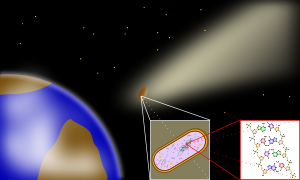പാൻസ്പെർമിയ
ഉൽക്കകൾ, ഛിന്നഗ്രഹങ്ങൾ, ധൂമകേതുക്കൾ, ഗ്രഹശകലങ്ങൾ എന്നിവയിലൂടെയാണ് ജീവൻ പ്രപഞ്ചത്തിലെങ്ങും വ്യാപിച്ചത് എന്ന് അവകാശപ്പെടുന്ന പരികല്പന.[1][2][3]

ബഹിരാകാശത്ത് ഉടലെടുക്കുന്ന ജീവകണങ്ങൾ അവിടെ നിന്ന് രക്ഷപ്പെട്ട് ബഹിരാകാശ ധൂളീപടലങ്ങളിൽ കൂടി കാലങ്ങളോളം സഞ്ചരിച്ച് മറ്റു ഗ്രഹങ്ങളിലോ പ്രദേശങ്ങളിലോ എത്തിച്ചേരുന്നു. അവിടങ്ങളിലെ അനുകൂല പരിതഃസ്ഥിതി ഉപയോഗപ്പെടുത്തി അവ പരിണാമത്തിനു വിധേയമായി കൂടുതൽ സങ്കീർണ്ണ ഘടനയിലുള്ള ജീവരൂപങ്ങളായി മാറുന്നു എന്നാണ് ഈ പരികല്പന മുന്നോട്ടു വെയ്ക്കുന്ന വാദം. അതായത് പാൻസ്പെർമിയ ജീവൻ എങ്ങനെ ഉണ്ടായി എന്നു വിശദീകരിക്കുന്നില്ല. പകരം അത് എങ്ങനെയാണ് വിതരണം ചെയ്യപ്പെട്ടത് എന്നാണ് പറയുന്നത്.[4][5][6]
ചരിത്രം
തിരുത്തുകപാൻസ്പെർമിയ എന്ന പദം ആദ്യമായി ഉപയോഗിച്ചത് ബി.സി. അഞ്ചാം നൂറ്റാണ്ടിൽ ജീവിച്ചിരുന്ന ഗ്രീക്ക് അനക്സഗോറസ് എന്ന തത്ത്വചിന്തകനായിരുന്നു.[7] പിന്നീട് ഇത് കൂടുതൽ ശാസ്ത്രീയമായി വികസിപ്പിച്ചത് ജോൺസ് ജേക്കബ് ബെർസീലിയസ് (1834)[8] ഹെർമ്മൻ ഇ. റിച്ചർ (1865)[9] കെൽവിൻ (1871)[10] ഹെർമൻ വോൺ ഹെൽമോൾട്സ് (1879)[11][12] എന്നിവരായിരുന്നു. ഈ പരികല്പന കൂടുതൽ വിശദാംശങ്ങളോടു കൂടി ഇന്നത്തെ രീതിയിൽ വികസിപ്പെച്ചെടുത്തത് സ്വീഡിഷ് രസതന്ത്രജ്ഞനായ സ്വാന്തെ അറീനിയസ് (1903) ആണ്.[13]
സർ ഫ്രെഡ് ഹോയ്ൽ (1915-2001) ചന്ദ്ര വിക്രമസിംഗെ (ജ.1939) എന്നീ ശാസ്ത്രജ്ഞർ ഈ സിദ്ധാന്തത്തെ സാധൂകരിക്കുന്നതിനുള്ള കൂടുതൽ തെളിവുകൾ കണ്ടെത്തി.[14][15] നക്ഷത്രാന്തരീയ പടലങ്ങളിൽ ജൈവപദാർത്ഥങ്ങൾ ധാരാളം കണ്ടേക്കാമെന്ന ഒരു പരികല്പന 1974ൽ ഇവർ മുന്നോട്ടു വെച്ചു. പിന്നീട് വിക്രമസിംഗെ ഇതിന് കൂടുതൽ തെളിവുകൾ നൽകുകയും ചെയ്തു.[16][17][18] ഹോയലും വിക്രമസിംഗെയും ഇപ്പോഴും ഇത്തരം ജൈവപദാർത്ഥങ്ങൾ ഭൂമിയിൽ പ്രവേശിച്ചു കൊണ്ടിരിക്കുന്നു എന്ന അഭിപ്രായക്കാരാണ്. വൻതോതിലുണ്ടാവുന്ന പകർച്ചവ്യാധികൾ, പുതിയ രോഗങ്ങൾ, വലിയതോതിലുള്ള ജനിതകമാറ്റങ്ങൾ ഉണ്ടാകുന്നതിനുള്ള കാരണം എന്നിവ ഇങ്ങനെ പുതുതായി ഭൂമിയിലേക്കു വരുന്ന ജൈവഘടകങ്ങളാണ് എന്നാണവരുടെ അഭിപ്രായം.[19]
ഭൗമേതരജീവികളെ കണ്ടെത്തുന്നതിൽ പാൻസ്പെർമിയ സിദ്ധാന്തമായിരിക്കും മനുഷ്യനെ സഹായിക്കാനെത്തുക എന്ന് പ്രസിദ്ധ ഭൗതികശാസ്ത്രജ്ഞനായ സ്റ്റീഫൻ ഹോക്കിങ് 2009ൽ അഭിപ്രായപ്പെടുകയുണ്ടായി.[20]
| “ | ഗ്രഹങ്ങളിൽ നിന്നും ഗ്രഹങ്ങളിലേക്കും നക്ഷത്രവ്യവസ്ഥകളിൽ നിന്നും നക്ഷത്രവ്യവസ്ഥകളിലേക്കും ജീവൻ പടർന്നെത്തിയത് ഉൽക്കകളിലൂടെയാണ് | ” |
അവലംബം
തിരുത്തുക- ↑ Wickramasinghe, Chandra (10 June 2010). "Bacterial morphologies supporting cometary panspermia: a reappraisal". International Journal of Astrobiology. 10 (1): 25–30. Bibcode:2011IJAsB..10...25W. doi:10.1017/S1473550410000157.
{{cite journal}}: Check date values in:|year=/|date=mismatch (help) - ↑ Napier, William (2011). "Exchange of Biomaterial Between Planetary Systems" (PDF). 16: 6616–6642.
{{cite journal}}: Cite journal requires|journal=(help); Unknown parameter|month=ignored (help)[പ്രവർത്തിക്കാത്ത കണ്ണി] - ↑ Rampelotto, P. H. (2010). Panspermia: A promising field of research. In: Astrobiology Science Conference. Abs 5224.
- ↑ A variation of the panspermia hypothesis is necropanspermia which is described by astronomer Paul Wesson as follows: "The vast majority of organisms reach a new home in the Milky Way in a technically dead state ... Resurrection may, however, be possible." Grossman, Lisa (2010-11-10). "All Life on Earth Could Have Come From Alien Zombies". Wired. Retrieved 2010-11-10.
{{cite news}}: Italic or bold markup not allowed in:|publisher=(help) - ↑ Hoyle, F. and Wickramasinghe, N.C., 1981. Evolution from Space (Simon & Schuster Inc., NY, 1981 and J.M. Dent and Son, Lond, 1981), ch3 pp35-49
- ↑ Wickramasinghe, J., Wickramasinghe, C. and Napier, W., 2010. Comets and the Origin of Life (World Scientific, Singapore. 1981), ch6 pp 137-154
- ↑ Margaret O'Leary (2008) Anaxagoras and the Origin of Panspermia Theory, iUniverse publishing Group, # ISBN 978-0-595-49596-2
- ↑ Berzelius (1799-1848), J. J. "Analysis of the Alais meteorite and implications about life in other worlds".
{{cite journal}}: Cite journal requires|journal=(help)CS1 maint: numeric names: authors list (link) - ↑ Lynn J. Rothschild and Adrian M. Lister (June 2003). Evolution on Planet Earth - The Impact of the Physical Environment. Academic Press. pp. 109–127. ISBN 978-0-12-598655-7. Retrieved 2013-07-21.
- ↑ Thomson (Lord Kelvin), W. (1871). "Inaugural Address to the British Association Edinburgh. "We must regard it as probably to the highest degree that there are countless seed-bearing meteoritic stones moving through space."". Nature. 4 (92): 261–278 [262]. Bibcode:1871Natur...4..261.. doi:10.1038/004261a0.
- ↑ "The word: Panspermia". New Scientist (2541). 7 March 2006. Retrieved 2013-07-25.
- ↑ "History of Panspermia". Archived from the original on 2014-10-13. Retrieved 2013-07-25.
- ↑ Arrhenius, S., Worlds in the Making: The Evolution of the Universe. New York, Harper & Row, 1908,
- ↑ Napier, W.M. (2007). "Pollination of exoplanets by nebulae". Int.J.Astrobiol. 6 (3): 223–228. Bibcode:2007IJAsB...6..223N. doi:10.1017/S1473550407003710.
- ↑ Line, M.A. (2007). "Panspermia in the context of the timing of the origin of life and microbial phylogeny". Int. J. Astrobiol. 3. 6 (3): 249–254. Bibcode:2007IJAsB...6..249L. doi:10.1017/S1473550407003813.
- ↑ Wickramasinghe, D. T.; Allen, D. A. (1980). "The 3.4-µm interstellar absorption feature". Nature. 287 (5782): 518. doi:10.1038/287518a0.
- ↑ Allen, D. A.; Wickramasinghe, D. T. (1981). "Diffuse interstellar absorption bands between 2.9 and 4.0 µm". Nature. 294 (5838): 239. doi:10.1038/294239a0.
- ↑ Wickramasinghe, D. T.; Allen, D. A. (1983). "Three components of 3?4 ?m absorption bands". Astrophysics and Space Science. 97 (2): 369. Bibcode:1983Ap&SS..97..369W. doi:10.1007/BF00653492.
- ↑ Fred Hoyle, Chandra Wickramasinghe and John Watson (1986). Viruses from Space and Related Matters. University College Cardiff Press.
- ↑ 20.0 20.1 Weaver, Rheyanne (April 7, 2009). "Ruminations on other worlds". statepress.com. Archived from the original on 2013-10-24. Retrieved 25 July 2013.